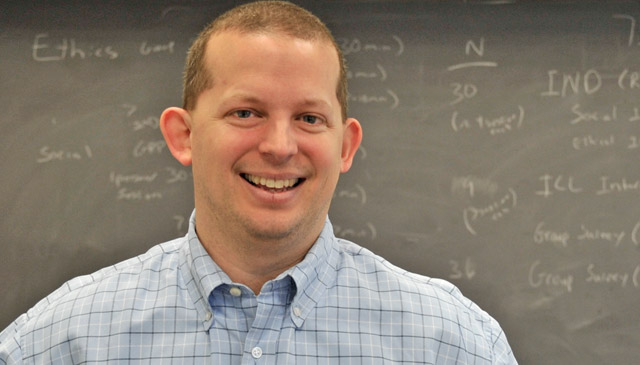Federal Standards, High School Missions Often at Odds

Americans have been bombarded over the past three decades with the news that our K-12 students are academically falling behind their peers dozens of countries. The U.S. government has responded by implementing a series of standardized tests and creating such programs as “Race to the Top” and “No Child Left Behind” to measure and improve our children’s success. The outcomes of these initiatives are often used to determine teacher effectiveness, as well.
“These programs are based on an assumption that has rarely been questioned by researchers and policy makers–the assumption that there is a consensus about the fundamental purpose of schooling in American society,” says Steven Stemler, assistant professor of psychology.
“But how can you presume common standards for ‘success’ when we are all pretty sure the definitions of success for urban schools, suburban schools and rural schools don’t even match up in the same state, never mind nationwide?”
However, “pretty sure” is the operative phrase here. Though virtually everyone who studies educational performance will readily agree that schools vary in the way they approach “success” and “excellence” no one could really identify definitively what those approaches were or how they differed.
“Of course there are different kinds of approaches in general – KIPP schools, Montessori schools, Waldorf schools and so on,” Stemler says. “But even within those frameworks, we wondered if there was some way of determining what each individual school believed defined success for them. And then we said, of course there is: mission statements.”
“Every school has to have a mission statement,” Stemler says. “Granted, some may be perfunctory, but we wondered what we’d find if we systematically compared schools’ stated aims with the aims of government-mandated accountability programs.”
Stemler and his co-authors, Damian Bebell of Boston College, and Lauren Sonnabend ‘08, MA ‘09, selected 10 geographically and politically diverse states, including states that receive significant national scrutiny – California, Florida, Michigan, New York, and North Carolina – as well as Alabama, Colorado, Iowa, Washington. In each state, 50 high schools were randomly selected; the results included a wide distribution of urban, suburban and rural schools.
“Most had their mission statements online; for others we had to make formal requests,” Stemler says. “In all we ended up with 421, which gave us enough to study.”
Within these mission statements, Stemler, Bebell, and Sonnabend found three themes that dominated in virtually every state: civic development (58 percent of mission statements), emotional development (55 percent), and cognitive development (53 percent).
“What’s interesting is that there are systematic differences from state to state with regard to the themes they emphasize. In states such as Texas and Florida, which were among the first to embrace the test-based accountability initiatives, cognitive development ranked as the highest priority,” Stemler says. “But in states like New York and California, which have historically had large immigrant populations, we find that civic development is the most frequently cited element.”
Stemler adds that schools in one outlier, Colorado, had a category outside of the top three. School mission statements in that state most frequently mentioned that their role was to provide a safe and nurturing environment.
“This makes sense because, after the Columbine shootings, people in Colorado became focused first and foremost on safety in their schools.”
The complete results were published under the title “Using School Mission Statements for Reflection and Research” in the most recent issue of the Educational Administration Quarterly.
“The findings from this research are particularly interesting when you consider the fact that the standardized tests that are being used as a graduation requirement are based almost exclusively on the cognitive element, with the primary emphasis being on mathematics and reading achievement.”
Stemler agrees that an emphasis on cognitive development is warranted; however, he points out that their data show that in many cases the primary aims of schools are quite different and customized to their particular setting. Urban students, students in middle class affluent suburbs, and rural students all face different challenges. There needs to be a re-evaluation by the government recognizing that there is not a single definition of ‘success’ when it comes to our children or our teachers. Education is much more complex and nuanced than that.
When students’ graduation decision hinge on just one of many purposes of schooling), the accountability system is nowhere close to comprehensive. Simply adding Science or History to the test will not make it comprehensive. Those are still areas focused on the cognitive purpose of schooling. Rather, what is needed is some way to measure these broader elements such as civic and emotional development. That is the primary aim of the research in my psychometric lab at Wesleyan and that is where I believe the government should be focusing their efforts as well.
“The question is ultimately about who gets to decide what the purpose of school is?” Stemler says. “Should it be mandated from a federal perspective to be just one thing, or should schools have the right to determine for themselves what it is they value, so long as they are held accountable for making progress toward their own goals?”
Stemler says their data offer opportunities for discussion and perhaps for the federal government to consider adjusting their approach.
For more information, please visit Stemler and Bebell’s website purposeofschool.com

